There are 11 scorpion species that have been recorded in New Mexico.
Knowing the scorpions and which ones are dangerous, can help you quickly identify them when you come across them, whether in a woodpile, by lifting a rock, or when exploring dry regions.
Continue reading to found out more about the scorpions you can find in New Mexico.
Table of Contents
Are Scorpions In New Mexico Dangerous?
All scorpions are armed with pincers at a stinger on the end of their tails, which causes pain, swelling, redness, and itching.
You can be allergic to the venom, the same as a bee or wasp sting. If you experience any allergic reactions to the sting, seek medical treatment immediately.
There is only one of the eleven scorpions in New Mexico that is dangerous to humans, that is the Arizona bark scorpion. It is the only one that will cause serious illness and in some cases can be fatal.

The Arizona bark scorpion is mostly observed in the southwest corner of New Mexico.
Types Of Scorpions In New Mexico
The eleven scorpions you may come across in New Mexico include:
1. Lesser Stripetail Scorpion
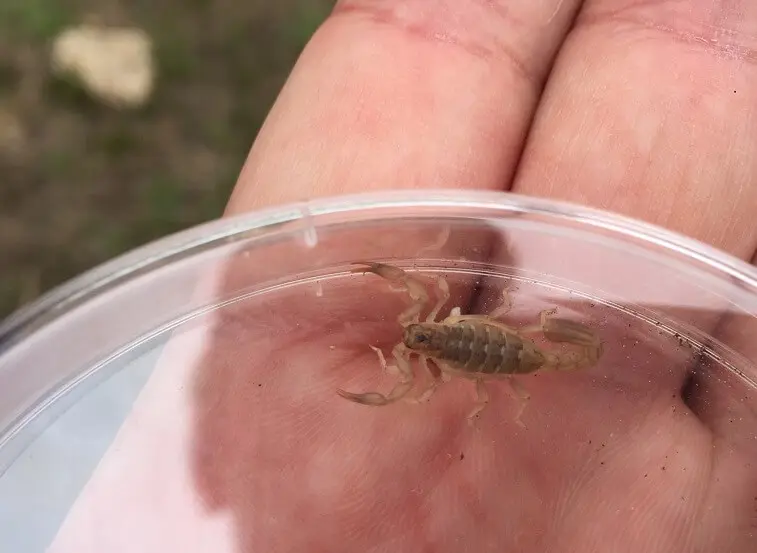
Scientific name: Chihuahuanus coahuilae.
Common name: Lesser stripetail scorpion.
The lesser stripetail scorpion is a member of the Vaejovidae family. It has a mottled carapace and can be found in most regions in New Mexico.
Due to being nocturnal, only coming out at night to prey on insects, and the fact that they are excellent burrowers, they are only observed when you pick up a rock or disturb them when taking wood from the woodpile in your yard.
2. Striped Bark Scorpion

Scientific name: Centruroides vittatus.
Common name: Striped bark scorpion.
The striped bark scorpion is a medium-sized scorpion that grows to 2.45 inches (7cm).
They are pale yellow in color with two dark stripes on the carapace. The colors do vary from very pale yellow to those with no stripes. Their color helps them blend in their environment, camouflaging themselves from predators.
These scorpions can be observed in the Sangre de Cristo Mountains and Rio Grande in New Mexico.
They can occupy deserts, forests, and grasslands. They can often be found hiding under rocks, in crevices, and hiding in old sheds and barns. They can also be found in houses during the day.
The striped bark scorpion is partially arboreal, spending its time in trees. Though most of the time is spent on the ground, where they climb at night to search for potential prey.
3. Russell’s Scorpion
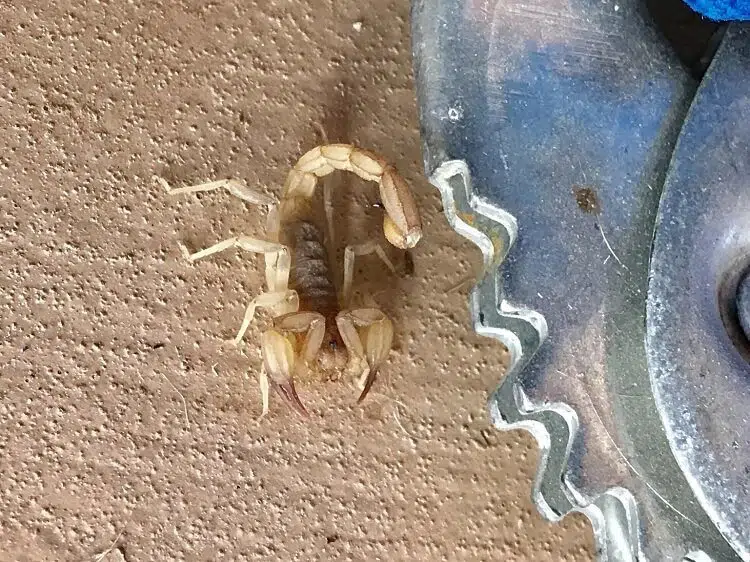
Scientific name: Chihuahuanus russelli.
Common name: Russell’s scorpion.
The Russell’s scorpion belongs to the Vaejovidae family and is endemic to the United States and is very common in New Mexico.
Adults grow to around two inches in length. They are yellow-brown in color with red fingers.
They prefer living in the forests and grassland areas, where they burrow under objects and at the base of plants.
4. Diplocentrus peloncillensis
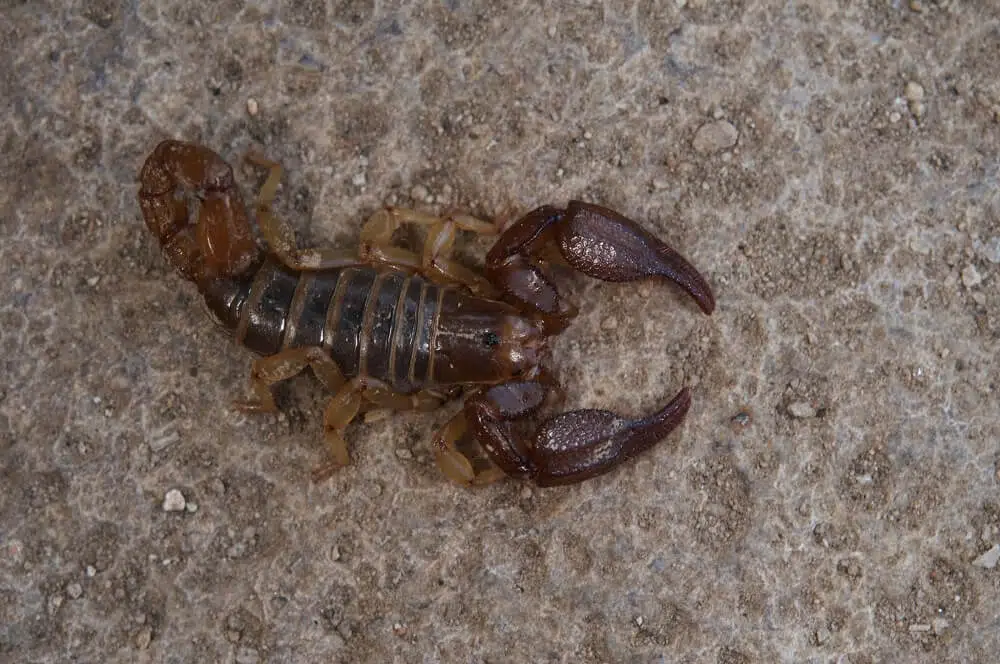
Diplocentrus Peloncillensis is the only single species of Diplocentrus, which is large and dark brown to black in color. Adults grow to around 7.5cm in length.
They prefer mountainous areas, where they can hide in crevices and under rocks during the day, hunting on insects at night.
5. Eastern Sand Scorpion
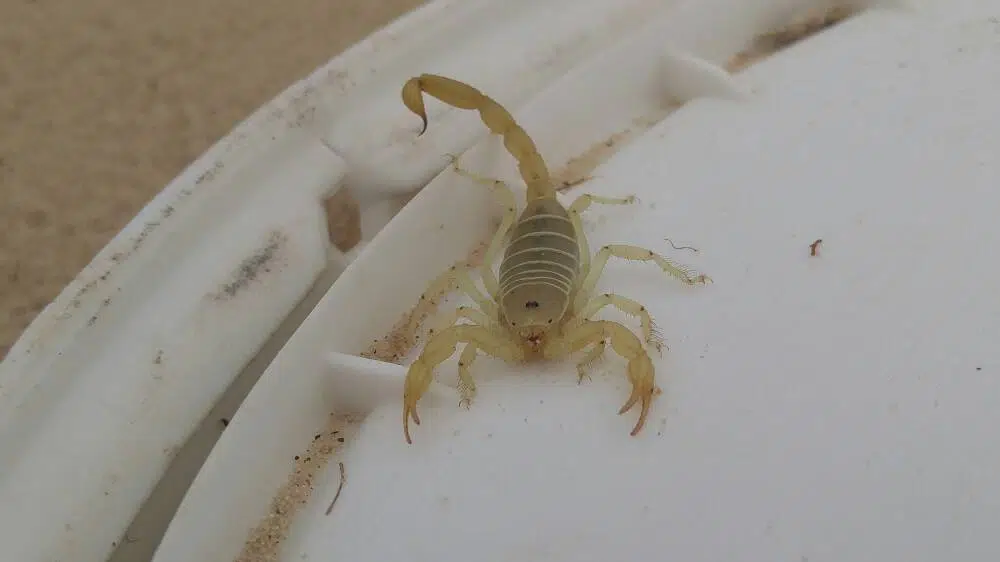
Scientific name: Paruroctonus utahensis.
Common name: Eastern sand scorpion.
The eastern sand scorpion is yellow to brown in color, matching the surrounding sand of its habitat.
They have swollen pincers and bristles on their legs, which helps them have excellent traction on the sandy surface.
They prefer loose soil and are excellent burrowers, digging their burrows on sand dunes and at the base of plants.
The eastern sand scorpion is a member of the Vaejovidae family, feeding mostly on large insects and spiders.
You can find these scorpions in just about every dune system located in New Mexico.
6. Stripe-tailed Scorpion

Scientific name: Paravaejovis spinigerus.
Common name: stripe-tailed scorpion, devil scorpion.
The stripe-tailed scorpion is also known as the devil scorpion and can be found in the southwestern parts of New Mexico.
It belongs to the Paravaejovis family and is a medium-sized scorpion that grows to around 7cm in length.
You can tell this scorpion apart from the dangerous Arizona Bark Scorpion by the stripes on its back. Their base color can vary from light yellow to golden brown.
They are commonly found in the Sonoran Desert, located under rocks and in objects, including shoes and sleeping bags.
Their sting is painful and can cause discomfort for up to two days, but the venom is not considered medically significant.
7. Arizona Bark Scorpion

Scientific name: Centruroides sculpturatus.
Common name: Arizona bark scorpion.
The Arizona bark scorpion is the only scorpion in New Mexico that is dangerous to humans.
This small light brown scorpion is found in the Sonoran Desert with males growing to 8cm and females growing to 7cm.
They are nocturnal and well adapted to live in desert areas with a water retention exoskeleton. They hide during the day under rocks and tree bark, along with woodpiles.
Unlike other scorpions, the Arizona bark scorpion does not burrow and is common in homes. They prefer habitats of sycamore groves and cottonwood, with plenty of moisture to attract insects. They are able to climb trees and walls.
The problem is that they prefer being upside down, which is the reason why people get stung. You may not see it under an object that you pick up. They can be found in western New Mexico.
This is the most venomous scorpion in the whole of North America and the venom can cause vomiting, numbness, and tingling, which can last up to three days. It’s not uncommon for the area to become immobilized and for the person to even experience convulsions.
Some people have experienced shortness of breath for a short period of time.
If you are stung by one of these scorpions, it is recommended that you seek medical treatment, as their venom can be fatal.
8. Thick-handed Scorpion
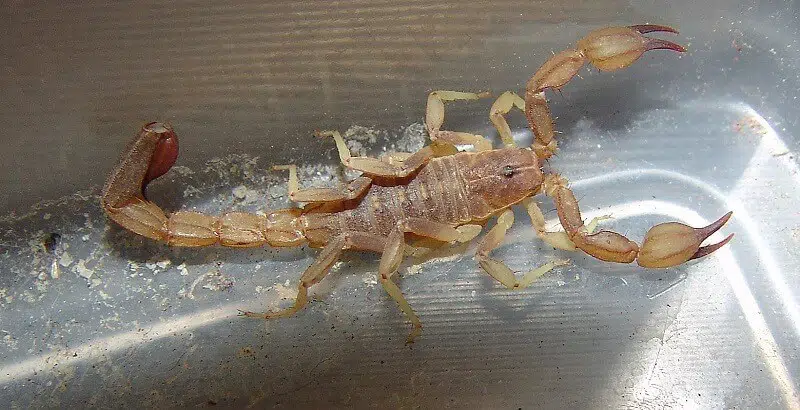
Scientific name: Chihuahuanus crassimanus.
Common name: Thick-handed scorpion.
Thick-handed scorpions are sandy in color, which helps them blend into their habitat and they are nocturnal, only coming out at night to hunt, which is why there have been so few observations in New Mexico.
They are very shy scorpions and excellent burrowers.
9. Superstition Mountains Scorpion

Scientific name: Superstitionia donensis.
Common name: Superstition mountains scorpion.
The superstition mountains scorpion is the only species in the Superstitionia genus and the Superstitioonidae family. It was first discovered in Arizona in 1940 and can be found in western New Mexico.
They prefer mountainous terrain where they hid under rocks and in desert areas, where they can be found near plants.
This scorpion has a different venom make up to other more common scorpions, but their venom is no more dangerous, it will cause pain, itching, swelling, and redness at the sting area for up to two days.
10. Trans-Pecos Smoothclaw Scorpion
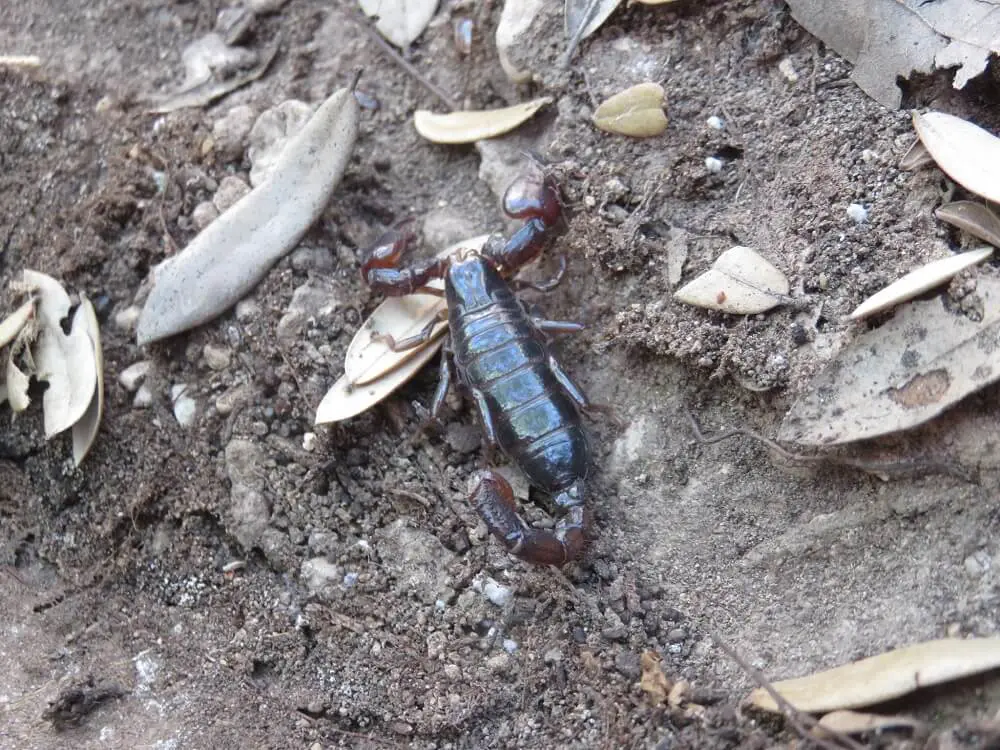
Scientific name: Diplocentrus lindo.
Common name: Trans-Pecos Smoothclaw Scorpion.
There have been hundreds of observations of the trans-pecos smoothclaw scorpions, which prefer desert regions and are excellent burrowers.
Their body color is maroon and their sting is painful, yet not dangerous to humans.
11. Cash’s Scorpion
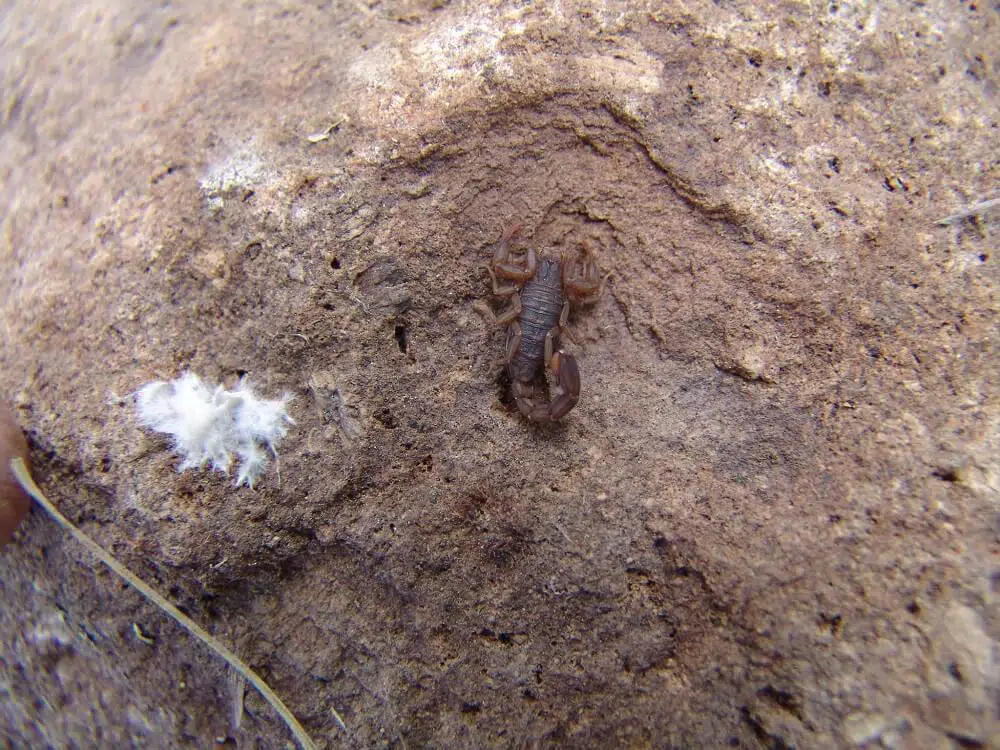
Scientific name: Vaejovis cashi.
Common name: Cash’s scorpion.
The cash’s scorpion can be found in southwestern New Mexico, usually in rocky areas. They spend their days hidden under tree bark, rocks, and surface objects.
They are not burrowers and hide under objects on the ground surface, coming out at night to feed on prey that they catch.
Where To Find New Mexico Scorpions?
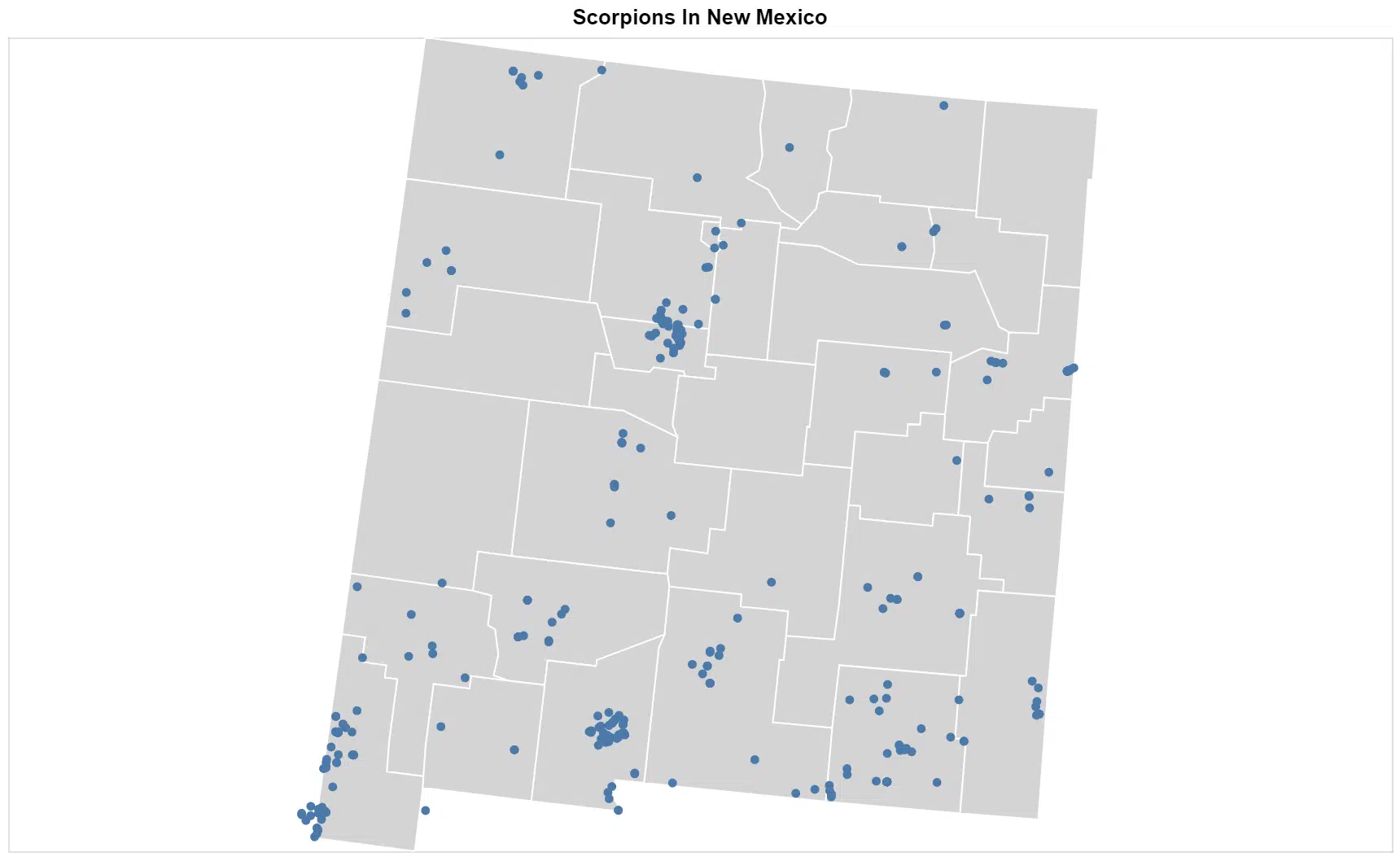
New Mexico scorpions can be found in the mountain, desert, grassland, and desert regions. They may be found in old barns and sheds, homes, and outdoors in woodpiles and debris.
The Arizona bark scorpion, which is the only dangerous scorpion in humans, is often observed in the southwestern corner of New Mexico.
They can thrive in just about any temperature and do well in freezing and warm temperatures. The most common time to observe scorpions in the area is from March through to October.
Note that scorpions can sometimes be seen in swimming pools. They can not swim but can survive in the water for up to 48 hours.
What To Do If You See A Scorpion?
If you see a scorpion in the wild, whether you pick up a rock or come across it by mistake, it’s best to leave it alone. Most scorpions will try and get away and escape, only stinging if they are threatened or provoked.
It is important to remember that even though the majority of scorpions in New Mexico are not deadly to humans, their stings are very painful and a sting will hurt.
Staying calm and moving slowly are the first steps when you come across a scorpion.
They do move fast when they feel threatened, so keep a close eye on it to ensure it doesn’t hide away and you cannot find it.
Some will play dead, as a tactic to put off any predators, which is why you must never touch a scorpion with your hand.
Always use a container or glass jar to capture it, sliding a piece of cardboard underneath and turning it over, capturing the scorpion inside. Once you have it safely in the container, set it free far from your property.
How To Get Rid Of Scorpions In New Mexico
It’s important to note that a scorpion can flatten itself to 1/16th of an inch, enabling it to fit into the smallest crevices. It can get through a tiny crack in the window or door.
Some scorpions are great climbers, which gets them into the home, sometimes getting a ride straight into the home on clothes, shoes, and other materials that you bring into the home, even your grocery bags.
Seal Small Openings
To reduce the risk of scorpions coming into your home, you will want to seal any small openings you find, some tips include:
- Use mortar or caulking to seal exterior cracks
- Seal any cracks in your foundation
- Inspect your plumbing fixtures regularly for spaces and seal them, along with roof eaves.
- Keep your window screens in good condition
- Seal loose doors with weather stripping
- Cover any weep holes, which are found on brick homes to reduce moisture. You can use mesh or wire on weep holes to reduce scorpions getting in.
Keep Your Yard Clean
You are more likely to have scorpions in your home if they have somewhere close by where they can eat and live. Good yard management is essential to get rid of scorpions in New Mexico.
Some tips include:
- Remove any building materials and trash in your yard
- Store firewood away from the house and keep it off the ground
- Keep bushes and trees trimmed back to ensure that they don’t touch the house
- Mow your grass regularly to reduce the risk of scorpions hiding in the tall grassland
General Tips
In addition to sealing any cracks in the home and ensuring excellent yard management, there are a few other things you can do to reduce the risk of scorpions, these include:
- Never leave shoes or clothing lying in the yard
- Hang up wet towels so they can try quickly, wet towels can attract scorpions in hot weather
- Change outdoor lights to yellow, which is less attractive to insects and therefore will not be too attractive to scorpions
- Always wear thick gloves when you handle your firewood.
Summary
The majority of scorpions in New Mexico are not dangerous and almost all of them will run and hide if they are approached or feel nervous.
Scorpions are shy in nature and spend their time hiding underground or under debris, coming out at night to hunt.
They will only sting if they feel threatened, which is why it’s best to leave them alone. If you find them in the wild or remove them with care, using a container, if you find them in your home. Always set them free far from your property.
Further Reading: